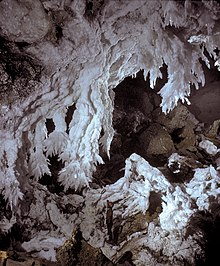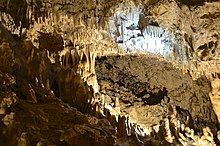
A solutional cave, solution cave, or karst cave is a cave usually formed in a soluble rock like limestone (Calcium carbonate CaCO3). It is the most frequently occurring type of cave. It can also form in other rocks, including chalk, dolomite, marble, salt beds, and gypsum.
Process
Bedrock is dissolved by carbonic acid in rainwater, groundwater, or humic acids from decaying vegetation, that seeps through bedding planes, faults, joints, and the like. Over time, the surface terrain breaks up into clints separated by grikes and punctuated by sinkholes into which streams may disappear, crevices expand as the walls are dissolved to become caves or cave system. These may turn into large caverns or dolines when the roof collapses.
The portions of a solutional cave that are below the water table or the local level of the groundwater are flooded.
Limestone caves

The largest and most abundant solutional caves are located in limestone. Limestone caves are often adorned with calcium carbonate formations produced through slow precipitation. These include flowstones, stalactites, stalagmites, helictites, soda straws, calcite rafts, and columns. These secondary mineral deposits in caves are called "speleothems".
Carbonic acid dissolution
Limestone dissolves under the action of rainwater and groundwater charged with H2CO3 (carbonic acid) and naturally occurring organic acids. The dissolution process produces a distinctive landform known as "karst", characterized by sinkholes and underground drainage. Solutional caves in this landform—topography are often called karst caves.
Sulfuric acid dissolution
Lechuguilla Cave in New Mexico and nearby Carlsbad Caverns are now believed to be examples of another type of solutional cave. They were formed by H2S (hydrogen sulfide) gas rising from below, where reservoirs of petroleum give off sulfurous fumes. This gas mixes with ground water and forms H2SO4 (sulfuric acid). The acid then dissolves the limestone from below, rather than from above, by acidic water percolating to the surface.
Examples
Australia
- Jenolan Caves, New South Wales
Malaysia
Taiwan
- Black Dwarf Cave, Pingtung County
United States
- Jewel Cave National Monument, South Dakota
- Mammoth Cave National Park, Kentucky
- Russell Cave National Monument, Alabama
- Wind Cave National Park, South Dakota
- Oregon Caves National Monument and Preserve, Oregon
- Cumberland Caverns, Tennessee
Vietnam
Germany
References
- "Solution Caves - Caves and Karst". U.S. National Park Service.
- ^ "Geology, Geography, and Meteorology". The Ultimate Visual Dictionary. D.K. Pub. 2012. p. 284-285. ISBN 978-0-1434-1954-9.
- Burcham, John. "Learning about caves; how caves are formed". Journey into amazing caves. Project Underground. Retrieved September 8, 2009.
- German Misplaced Pages: Kolbinger Höhle
- "Speleothem - National Centers for Environmental Information (NCEI)". National Centers for Environmental Information. Retrieved 2 January 2025.
- Bewley, Djuna. "Soda Straws - National Speleological Society". National Speleological Society. Retrieved 2 January 2025.
Sources
- Gunn, John (2004). Encyclopedia of Caves and Karst Science (2nd ed.). Routledge. pp. 417, 1421.
- Young, Rob; Norby, Lisa (2009). Geological Monitoring. Geological Society of America. p. 27.
- Goudie, Andrew; Panizza, Mario (2014). Encyclopedia of Geomorphology. Routledge. p. 124.
External links
 Media related to Karst caves at Wikimedia Commons
Media related to Karst caves at Wikimedia Commons
| Cave topics | |
|---|---|
| Glossary of caving and speleology | |
| Main topics | |
| Types and formation processes | |
| Speleothems and Speleogens (Cave formations) | |
| Dwellings | |
| Popular culture | |
| Incidents | |